

Der Weg in den Krieg : Eine Falschmeldung zerstört das letzte Vertrauen - Nachrichten Geschichte. Die Ermordung des österreichischen Thronfolgers Franz Ferdinand und seiner Frau am 28.

Juni 1914 in Sarajevo setzte hektische politische Aktivitäten in Gang. Sie sind unter dem Begriff "Juli-Krise" in die Geschichte eingegangen. Dass am Ende der Ausbruch eines Weltkriegs stehen würde, war keineswegs ausgemacht. Politiker und Diplomaten suchten nach Lösungen für eine ganze Reihe von Konflikten, deren Tragweiten und Verflechtungen sie kaum zu überblicken vermochten. Als "Schlafwandler" beschreibt der australische Historiker Christopher Clark die Akteure von 1914: von Albträumen geplagt, aber unfähig, die Realität der Gräuel zu erkennen, die sie in Kürze in die Welt setzen würden. Wilhelm II. versteht Bahnhof. Guerre 14-18. David Rumsey Historical Map Collection. Historische Landkarten in GoogleEarth. Aus GenWiki, dem genealogischen Lexikon zum Mitmachen.
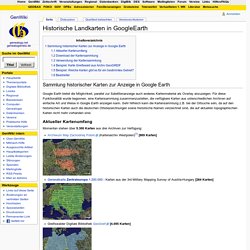
Adaptiver, Interaktiver, Dynamischer Atlas zur Geschichte (AIDA). Visuelles Erkunden und interaktives Erleben der Geschichte. Europe Atlas. Europe Mountains Rivers of Europe Europe Cities Europe Countries Special Territories Explanation.

Utah Petroglyphs in light of the Skinwalker Phenomena. It is often considered that the modern phenomena observed at the Skinwalker ranch could certainly be what the local tribespeople of the region, the Ute, illustrated in their petroglyphs, but this generally doesn't extend much beyond the gee whiz that sure looks like some kind of alien approach, and is countered by mention of shaman, fertility ritual and solar symbolism, but i'd like to try and present a few more particular observations here.
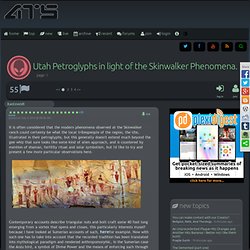
Contemporary accounts describe triangular nuts and bolt craft some 40 foot long emerging from a vortex that opens and closes, this particularly interests myself because i have looked at Sumerian accounts of such, herefor example. So in looking at the triangular figures above they are given a sense of being albeit highly abstract, and the same approach i have observed in the Sumerian tradition, but yet the Anzu can also be represented as an entirely geometric/aerodynamic figure. Barrier Canyon Rock Art.
Barrier Canyon Style Rock Art Gallery.

Australian Petroglyphs, Wondjina. Australian Petroglyphs and Rock Art Significant early cave paintings have been found in Kakadu, Australia.
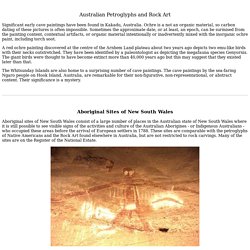
Ochre is a not an organic material, so carbon dating of these pictures is often impossible. Sometimes the approximate date, or at least, an epoch, can be surmised from the painting content, contextual artifacts, or organic material intentionally or inadvertently mixed with the inorganic ochre paint, including torch soot. A red ochre painting discovered at the centre of the Arnhem Land plateau about two years ago depicts two emu-like birds with their necks outstretched. They have been identified by a paleontologist as depicting the megafauna species Genyornis. View the World: Pumapunku , Boliva. Pumapunku also called Puma Pumku or Puma Puncu, is part of a large temple complex or monument group that is part of the Tiwanaku Site near Tiwanaku, Bolivia.
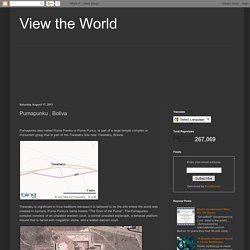
Tiwanaku is significant in Inca traditions because it is believed to be the site where the world was created.In Aymara, Puma Punku's name means "The Door of the Puma". The Pumapunku complex consists of an unwalled western court, a central unwalled esplanade, a terraced platform mound that is faced with megalithic stone, and a walled eastern court. The Pumapunku is a terraced earthen mound that is faced with megalithic blocks. It is 167.36 meters wide along its north-south axis and 116.7 meters long along its east-west axis. On the northeast and southeast corners of the Pumapunku it has 20-meter wide projections that extend 27.6 meters north and south from the rectangular mound. Evolution: Modern Synthesis: Introduction. Darwin's book, On the Origin of Species met immediate popularity.

It sold so well that the publishers undertook a second printing a mere month after the first. However, the ideas contained in Origin were not immediately accepted. This disparity arose in large part because of the simple fact that the world had not yet discovered genetics. Human Y-chromosome DNA haplogroup. Dominant Y-chromosome haplogroups in pre-colonial world populations, with possible migrations routes according to the Coastal Migration Model.
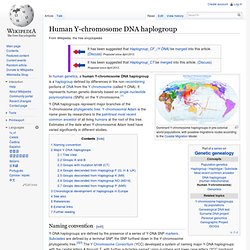
Human mitochondrial DNA haplogroup. Hypothesized world map of human migrations, with the North Pole at center.
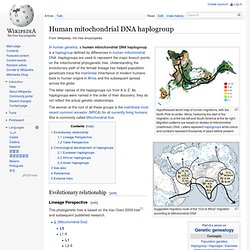
Africa, harboring the start of the migration, is at the top left and South America at the far right. Migration patterns are based on studies of mitochondrial (matrilinear) DNA. Letters represent haplogroups while colors and numbers represent thousands of years before present. Suggested migratory route of the "Out of Africa" migration according to Mitochondrial DNA In human genetics, a human mitochondrial DNA haplogroup is a haplogroup defined by differences in human mitochondrial DNA. Mtdna-migrationmap-FTDNA2006.jpg 1 663 × 1 284 pixels. FTDNA-Y-DNAmap-2009.jpg 3 101 × 2 374 pixels.
Atlas of the Human Journey - The Genographic Project. When humans first ventured out of Africa some 60,000 years ago, they left genetic footprints still visible today. By mapping the appearance and frequency of genetic markers in modern peoples, we create a picture of when and where ancient humans moved around the world. These great migrations eventually led the descendants of a small group of Africans to occupy even the farthest reaches of the Earth. Our species is an African one: Africa is where we first evolved, and where we have spent the majority of our time on Earth. The earliest fossils of recognizably modern Homo sapiens appear in the fossil record at Omo Kibish in Ethiopia, around 200,000 years ago.
Although earlier fossils may be found over the coming years, this is our best understanding of when and approximately where we originated. According to the genetic and paleontological record, we only started to leave Africa between 60,000 and 70,000 years ago.